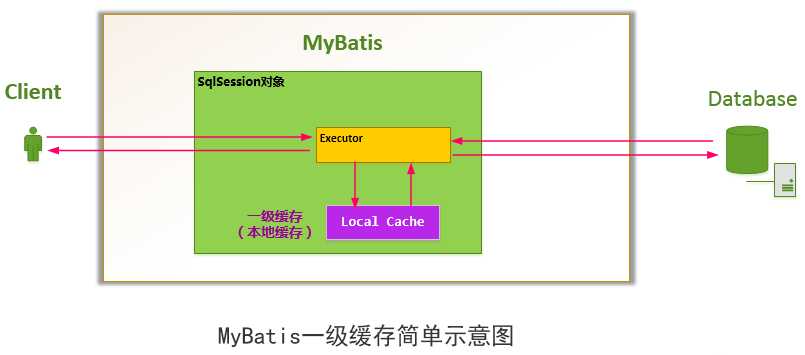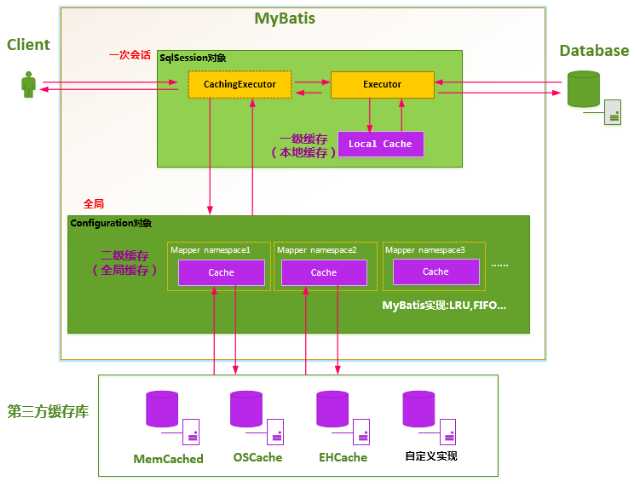Mybatis对缓存提供支持,但是在没有配置的默认情况下,它只开启一级缓存,一级缓存只是相对于同一个SqlSession而言。所以在参数和SQL完全一样的情况下,我们使用同一个SqlSession对象调用一个Mapper方法,往往只执行一次SQL,因为使用SelSession第一次查询后,MyBatis会将其放在缓存中,以后再查询的时候,如果没有声明需要刷新,并且缓存没有超时的情况下,SqlSession都会取出当前缓存的数据,而不会再次发送SQL到数据库。

为什么要使用一级缓存,不用多说也知道个大概。但是还有几个问题我们要注意一下。
1、一级缓存的生命周期有多长?
a、MyBatis在开启一个数据库会话时,会 创建一个新的SqlSession对象,SqlSession对象中会有一个新的Executor对象。Executor对象中持有一个新的PerpetualCache对象;当会话结束时,SqlSession对象及其内部的Executor对象还有PerpetualCache对象也一并释放掉。
b、如果SqlSession调用了close()方法,会释放掉一级缓存PerpetualCache对象,一级缓存将不可用。
c、如果SqlSession调用了clearCache(),会清空PerpetualCache对象中的数据,但是该对象仍可使用。
d、SqlSession中执行了任何一个update操作(update()、delete()、insert()) ,都会清空PerpetualCache对象的数据,但是该对象可以继续使用
2、怎么判断某两次查询是完全相同的查询?
mybatis认为,对于两次查询,如果以下条件都完全一样,那么就认为它们是完全相同的两次查询。
2.1 传入的statementId
2.2 查询时要求的结果集中的结果范围
2.3. 这次查询所产生的最终要传递给JDBC java.sql.Preparedstatement的Sql语句字符串(boundSql.getSql() )
2.4 传递给java.sql.Statement要设置的参数值
二级缓存:
MyBatis的二级缓存是Application级别的缓存,它可以提高对数据库查询的效率,以提高应用的性能。
MyBatis的缓存机制整体设计以及二级缓存的工作模式

SqlSessionFactory层面上的二级缓存默认是不开启的,二级缓存的开席需要进行配置,实现二级缓存的时候,MyBatis要求返回的POJO必须是可序列化的。 也就是要求实现Serializable接口,配置方法很简单,只需要在映射XML文件配置就可以开启缓存了<cache/>,如果我们配置了二级缓存就意味着:
- 映射语句文件中的所有select语句将会被缓存。
- 映射语句文件中的所欲insert、update和delete语句会刷新缓存。
- 缓存会使用默认的Least Recently Used(LRU,最近最少使用的)算法来收回。
- 根据时间表,比如No Flush Interval,(CNFI没有刷新间隔),缓存不会以任何时间顺序来刷新。
- 缓存会存储列表集合或对象(无论查询方法返回什么)的1024个引用
- 缓存会被视为是read/write(可读/可写)的缓存,意味着对象检索不是共享的,而且可以安全的被调用者修改,不干扰其他调用者或线程所做的潜在修改。
实践:
一、创建一个POJO Bean并序列化
由于二级缓存的数据不一定都是存储到内存中,它的存储介质多种多样,所以需要给缓存的对象执行序列化。(如果存储在内存中的话,实测不序列化也可以的。)
package com.yihaomen.mybatis.model;
import com.yihaomen.mybatis.enums.Gender;
import java.io.Serializable;
import java.util.List;
/**
* @ProjectName: springmvc-mybatis
*/
public class Student implements Serializable
private static final long serialVersionUID = 735655488285535299L;
private String id;
private String name;
private int age;
private Gender gender;
private List<Teacher> teachers;
setters&getters()....;
toString();
二、在映射文件中开启二级缓存
<?xml version="1.0" encoding="UTF-8" ?>
<!DOCTYPE mapper PUBLIC "-//mybatis.org//DTD Mapper 3.0//EN"
"http://mybatis.org/dtd/mybatis-3-mapper.dtd">
<mapper namespace="com.yihaomen.mybatis.dao.StudentMapper">
<!--开启本mapper的namespace下的二级缓存-->
<!--
eviction:代表的是缓存回收策略,目前MyBatis提供以下策略。
(1) LRU,最近最少使用的,一处最长时间不用的对象
(2) FIFO,先进先出,按对象进入缓存的顺序来移除他们
(3) SOFT,软引用,移除基于垃圾回收器状态和软引用规则的对象
(4) WEAK,弱引用,更积极的移除基于垃圾收集器状态和弱引用规则的对象。这里采用的是LRU,
移除最长时间不用的对形象
flushInterval:刷新间隔时间,单位为毫秒,这里配置的是100秒刷新,如果你不配置它,那么当
SQL被执行的时候才会去刷新缓存。
size:引用数目,一个正整数,代表缓存最多可以存储多少个对象,不宜设置过大。设置过大会导致内存溢出。
这里配置的是1024个对象
readOnly:只读,意味着缓存数据只能读取而不能修改,这样设置的好处是我们可以快速读取缓存,缺点是我们没有
办法修改缓存,他的默认值是false,不允许我们修改
-->
<cache eviction="LRU" flushInterval="100000" readOnly="true" size="1024"/>
<resultMap id="studentMap" type="Student">
<id property="id" column="id" />
<result property="name" column="name" />
<result property="age" column="age" />
<result property="gender" column="gender" typeHandler="org.apache.ibatis.type.EnumOrdinalTypeHandler" />
</resultMap>
<resultMap id="collectionMap" type="Student" extends="studentMap">
<collection property="teachers" ofType="Teacher">
<id property="id" column="teach_id" />
<result property="name" column="tname"/>
<result property="gender" column="tgender" typeHandler="org.apache.ibatis.type.EnumOrdinalTypeHandler"/>
<result property="subject" column="tsubject" typeHandler="org.apache.ibatis.type.EnumTypeHandler"/>
<result property="degree" column="tdegree" javaType="string" jdbcType="VARCHAR"/>
</collection>
</resultMap>
<select id="selectStudents" resultMap="collectionMap">
SELECT
s.id, s.name, s.gender, t.id teach_id, t.name tname, t.gender tgender, t.subject tsubject, t.degree tdegree
FROM
student s
LEFT JOIN
stu_teach_rel str
ON
s.id = str.stu_id
LEFT JOIN
teacher t
ON
t.id = str.teach_id
</select>
<!--可以通过设置useCache来规定这个sql是否开启缓存,ture是开启,false是关闭-->
<select id="selectAllStudents" resultMap="studentMap" useCache="true">
SELECT id, name, age FROM student
</select>
<!--刷新二级缓存
<select id="selectAllStudents" resultMap="studentMap" flushCache="true">
SELECT id, name, age FROM student
</select>
-->
</mapper>
三、在 mybatis-config.xml中开启二级缓存
<?xml version="1.0" encoding="UTF-8" ?>
<!DOCTYPE configuration PUBLIC "-//mybatis.org//DTD Config 3.0//EN"
"http://mybatis.org/dtd/mybatis-3-config.dtd">
<configuration>
<settings>
<!--这个配置使全局的映射器(二级缓存)启用或禁用缓存-->
<setting name="cacheEnabled" value="true" />
.....
</settings>
....
</configuration>
四、测试
package com.yihaomen.service.student;
import com.yihaomen.mybatis.dao.StudentMapper;
import com.yihaomen.mybatis.model.Student;
import com.yihaomen.mybatis.model.Teacher;
import com.yihaomen.service.BaseTest;
import org.apache.ibatis.session.SqlSession;
import org.apache.ibatis.session.SqlSessionFactory;
import java.util.List;
/**
*
* @ProjectName: springmvc-mybatis
*/
public class TestStudent extends BaseTest
public static void selectAllStudent()
SqlSessionFactory sqlSessionFactory = getSession();
SqlSession session = sqlSessionFactory.openSession();
StudentMapper mapper = session.getMapper(StudentMapper.class);
List<Student> list = mapper.selectAllStudents();
System.out.println(list);
System.out.println("第二次执行");
List<Student> list2 = mapper.selectAllStudents();
System.out.println(list2);
session.commit();
System.out.println("二级缓存观测点");
SqlSession session2 = sqlSessionFactory.openSession();
StudentMapper mapper2 = session2.getMapper(StudentMapper.class);
List<Student> list3 = mapper2.selectAllStudents();
System.out.println(list3);
System.out.println("第二次执行");
List<Student> list4 = mapper2.selectAllStudents();
System.out.println(list4);
session2.commit();
public static void main(String[] args)
selectAllStudent();
结果:
[QC] DEBUG [main] org.apache.ibatis.transaction.jdbc.JdbcTransaction.setDesiredAutoCommit(98) | Setting autocommit to false on JDBC Connection [[email protected]]
[QC] DEBUG [main] org.apache.ibatis.logging.jdbc.BaseJdbcLogger.debug(139) | ==> Preparing: SELECT id, name, age FROM student
[QC] DEBUG [main] org.apache.ibatis.logging.jdbc.BaseJdbcLogger.debug(139) | ==> Parameters:
[QC] DEBUG [main] org.apache.ibatis.logging.jdbc.BaseJdbcLogger.debug(139) | <== Total: 6
[Studentid=‘1‘, name=‘刘德华‘, age=55, gender=null, teachers=null, Studentid=‘2‘, name=‘张惠妹‘, age=49, gender=null, teachers=null, Studentid=‘3‘, name=‘谢霆锋‘, age=35, gender=null, teachers=null, Studentid=‘4‘, name=‘王菲‘, age=47, gender=null, teachers=null, Studentid=‘5‘, name=‘汪峰‘, age=48, gender=null, teachers=null, Studentid=‘6‘, name=‘章子怡‘, age=36, gender=null, teachers=null]
第二次执行
[QC] DEBUG [main] org.apache.ibatis.cache.decorators.LoggingCache.getObject(62) | Cache Hit Ratio [com.yihaomen.mybatis.dao.StudentMapper]: 0.0
[Studentid=‘1‘, name=‘刘德华‘, age=55, gender=null, teachers=null, Studentid=‘2‘, name=‘张惠妹‘, age=49, gender=null, teachers=null, Studentid=‘3‘, name=‘谢霆锋‘, age=35, gender=null, teachers=null, Studentid=‘4‘, name=‘王菲‘, age=47, gender=null, teachers=null, Studentid=‘5‘, name=‘汪峰‘, age=48, gender=null, teachers=null, Studentid=‘6‘, name=‘章子怡‘, age=36, gender=null, teachers=null]
二级缓存观测点
[QC] DEBUG [main] org.apache.ibatis.cache.decorators.LoggingCache.getObject(62) | Cache Hit Ratio [com.yihaomen.mybatis.dao.StudentMapper]: 0.3333333333333333
[Studentid=‘1‘, name=‘刘德华‘, age=55, gender=null, teachers=null, Studentid=‘2‘, name=‘张惠妹‘, age=49, gender=null, teachers=null, Studentid=‘3‘, name=‘谢霆锋‘, age=35, gender=null, teachers=null, Studentid=‘4‘, name=‘王菲‘, age=47, gender=null, teachers=null, Studentid=‘5‘, name=‘汪峰‘, age=48, gender=null, teachers=null, Studentid=‘6‘, name=‘章子怡‘, age=36, gender=null, teachers=null]
第二次执行
[QC] DEBUG [main] org.apache.ibatis.cache.decorators.LoggingCache.getObject(62) | Cache Hit Ratio [com.yihaomen.mybatis.dao.StudentMapper]: 0.5
[Studentid=‘1‘, name=‘刘德华‘, age=55, gender=null, teachers=null, Studentid=‘2‘, name=‘张惠妹‘, age=49, gender=null, teachers=null, Studentid=‘3‘, name=‘谢霆锋‘, age=35, gender=null, teachers=null, Studentid=‘4‘, name=‘王菲‘, age=47, gender=null, teachers=null, Studentid=‘5‘, name=‘汪峰‘, age=48, gender=null, teachers=null, Studentid=‘6‘, name=‘章子怡‘, age=36, gender=null, teachers=null]
Process finished with exit code 0
我们可以从结果看到,sql只执行了一次,证明我们的二级缓存生效了。
